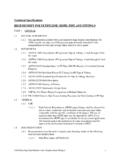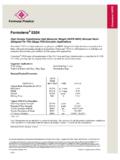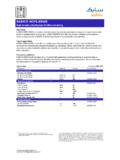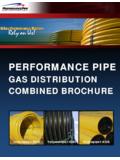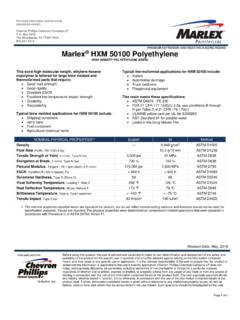Transcription of Aquaculture operations in oating HDPE cages
1 Cage Aquaculture has grown rapidly in recent decades, and there has been a move towards the development and use of more intensive cage-farming systems to access and expand into untapped open-water areas, particularly in marine offshore waters. Fish cages vary in design, size and materials used, as they have been designed for employment in diverse environments, ranging from relatively protected to highly exposed and dynamic sites, either as floating or fully submerged structures. This technical manual focuses on high-density polyethylene (HDPE) cages as they are widely used in modern industrial marine Aquaculture in many parts of the world.
2 It provides the reader with highly practical and technical information on the design and components of a typical HDPE cage, and on how a cage collar is assembled and the net pen installed. Along with the structure of the cage, comprehensive information on the grid mooring system and installation is provided. Finally, the manual presents and discusses information on farming operations , including maintenance and control of the farming structures, stocking of the farmed fish, feeding, harvesting and packaging as well as other practical aspects and routine management operations . Aquaculture operations in floating HDPE cagesA field handbook593 FAOA quaculture operations in floating HDPE cages A field handbook593 FAOFISHERIES ANDAQUACULTURETECHNICALPAPERISSN 2070-7010I4508E/1 978-92-5-108749-79789251 087497 ISSN 2070-7010 Cover photograph: A floating marine finfish cage farm (Tabuk Fisheries Company) located off the Red Sea coast of Saudi Arabia in the northern coastal province of Tabuk.
3 The HDPE cages are 19 m in diameter and fitted with anti-bird nets (Courtesy Francesco Cardia). Aquaculture operations in floating HDPE cagesA field handbook Francesco Cardia FAO Project ManagerKingdom of Saudi Arabiaand Alessandro LovatelliFAO Aquaculture BranchItaly FOOD AND AGRICULTURE ORGANIZATION OF THE UNITED NATIONSandMINISTRy OF AGRICULTURE OF THE kINGDOM OF SAUDI ARAbIARome, 2015 FAOFISHERIES ANDAQUACULTURETECHNICALPAPER593 The designations employed and the pr esentation of material in this information pr oduct do not imply the expression of any opinion whatsoever on the part of the Food and Agriculture Organization of the United Nations (F AO)
4 , or of the Ministry of Agriculture of the Kingdom of Saudi Arabia concerning the legal or development status of any country, territory, city or ar ea or of its authorities, or concerning the delimitation of its fr ontiers or boundaries. The mention of specific companies or pr oducts of manufacturers, whether or not these have been patented, does not imply that these have been endorsed or recommended by FAO, or the Ministry of Agriculture of the Kingdom of Saudi Arabia in pr eference to others of a similar nature that ar e not views expressed in this information pr oduct ar e those of the author(s)
5 And do not necessarily reflect the views or policies of FAO or the Ministry of 978-92-5-108749-7 FAO and Ministry of Agriculture of the Kingdom of Saudi Arabia, 2015 FAO and the Ministry of Agriculture of the Kingdom of Saudi Arabia encourage the use, reproduction and dissemination of material in this information pr oduct. Except where otherwise indicated, material may be copied, downloaded and printed for private study, research and teaching purposes, or for use in non-commercial pr oducts or services, pr ovided that appropriate acknowledgement of FAO and Ministry of Agriculture of the Kingdom of Saudi Arabia as the source and copyright holder is given and that FAO s or Ministry of Agriculture s endorsement of users views, pr oducts or services is not implied in any requests for translation and adaptation rights.
6 And for resale and other commercial use rights should be made via or addressed to information pr oducts ar e available on the FAO website ( ) and can be purchased through of this document The document has been funded and produced in the framework of the Technical Cooperation Programme between the Kingdom of Saudi Arabia and the Food and Agriculture Organization of the United Nations during the implementation of two unilateral trust fund projects, Support to the Fish Farming Center (FFC), Jeddah, Saudi Arabia and Strengthening and supporting further development of Aquaculture in the Kingdom of Saudi Arabia.
7 The purpose of this manual is to provide a general overview of farming and management techniques needed to operate high-density polyethylene (HDPE) floating fish-culture cages , including the types of materials used, their technical specifications and operability. The rationale behind this handbook is to contribute to the capacity building of technical staff on highly practical issues and the management of fish cage farms. Moreover, this publication provides entrepreneurs, managers and workers involved in cage farming with a reference manual where they can find a rich source of technical and biological information, ranging from farm installation to the entire production cycle.
8 The handbook also includes technical tables, logbook examples and functional suggestions acquired from years of field experience, which is shared with the readers. This publication is also addressed to administrations, institutional organizations and development agencies involved in planning, ruling, licensing, subsidizing, etc., with the main practical and technical issues of this relatively new branch of Aquaculture being systematically described and Aquaculture is nothing but fish production using a (relatively) new technological system. Thus, many of the issues related to fish biology, pathology, feeding, etc.
9 , are shared with all other fish production systems. For this reason, the authors have focused as much as possible on practical and operational issues related to cage Aquaculture , while readers are referred to more generic literature to obtain in-depth information on other and general Aquaculture handbook briefly covers some important topics such as work safety while others are not dealt with at all ( working boats and cranes, diving technique and equipment) as specific technical competences are required to treat these topics , procedures and operations described in this manual aim to provide the reader with possible solutions to problems and issues that are usually encountered in the cage farms.
10 Nevertheless, each procedure inevitably needs to be revised and adapted to each site condition, workers experience, and the availability of labour, equipment and auxiliary boats. ivAbstractGlobal Aquaculture production has been steadily growing in recent decades, increasingly contributing fish and other edible aquatic organisms of commercial importance entering national, regional and international markets. The growing demand for such products has stimulated the development and expansion of Aquaculture production systems both on land and in all waterbodies, covering technologies ranging from the production of seed material to ongrowing structures and other farming support recent decades, the Aquaculture industry has also intensified its production output per unit area of space or volume, mainly to compensate, among other things, for the growing competition for land and water surfaces for other uses.










